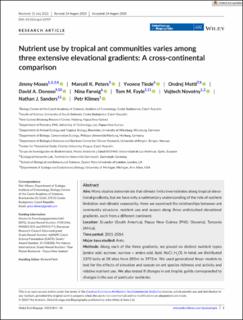| dc.description.abstract | Aim: Many studies demonstrate that climate limits invertebrates along tropical elevational gradients, but we have only a rudimentary understanding of the role of nutrient limitation and climatic seasonality. Here we examined the relationships between ant community structure, nutrient use and season along three undisturbed elevational gradients, each from a different continent.
Location: Ecuador (South America), Papua New Guinea (PNG: Oceania), Tanzania (Africa).
Time period: 2011–2014.
Major taxa studied: Ants.
Methods: Along each of the three gradients, we placed six distinct nutrient types (amino acid, sucrose, sucrose + amino acid, lipid, NaCl, H2O). In total, we distributed 2370 baits at 38 sites from 203 m to 3972 m. We used generalized linear models to test for the effects of elevation and season on ant species richness and activity and relative nutrient use. We also tested if changes in ant trophic guilds corresponded to changes in the use of particular nutrients.
Results: Both species richness and activity decreased with elevation along each gradient. However, there were significant interaction effects among elevation, region and season, as ant activity in the dry season was higher in Ecuador and Tanzania but lower in PNG. Relative nutrient use varied among regions: ant preference for some nutrients changed with increasing elevation in Ecuador (decrease in lipid use) and Tanzania (decrease in amino acid and H2O use), while season affected nutrient use in PNG. There were common trends in trophic guilds along the three elevational gradients (e.g. proportional increase of predators), but these did not explain most of the nutrient use patterns.
Main conclusion: While the structure of ant communities changed similarly with elevation, both the seasonal and elevational effects on nutrient use by ants differed between continents. We argue that regional differences in climate and nutrient availability rather than ant functional composition shape nutrient use by ants. | en_US |

